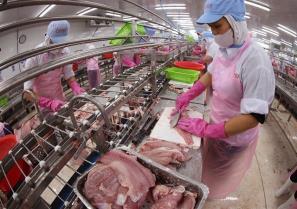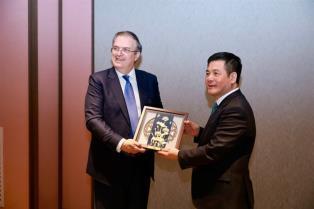By the end of 2024, Việt Nam had 8,274 markets, 276 shopping malls and 1,293 supermarkets. However, most first- and second-class markets were concentrated in urban centres, while third-class markets dominated rural and mountainous areas. Disparities in infrastructure, management and service quality have created gaps that leave room for commercial fraud.

HÀ NỘI — Building stronger market linkages and maintaining stable supply chains are crucial to boosting competitiveness, expanding exports and elevating the global presence of Vietnamese products, said Bùi Quang Hưng, deputy director of the Vietnam Trade Promotion Agency under the Ministry of Industry and Trade (MoIT).
Speaking at a conference on Thursday in Hà Nội, Hưng said the global economy has faced profound fluctuations in recent years, including uneven regional growth, rising trade protectionism, escalating geopolitical tensions, shifting trade policies, the emergence of new industries and the impacts of climate change—all of which are strongly affecting global supply chains.
He stressed that new international requirements on sustainable development, carbon emission reduction, green transformation and digitalised trade are becoming decisive standards. Vietnamese enterprises, he said, must swiftly adapt if they want to maintain their positions and expand their export markets.
Turning to the domestic market, Hưng highlighted that Việt Nam, with more than 100 million people, represents a major driver of growth. However, he pointed out shortcomings in connecting production, distribution and consumption, as well as the limited resilience of domestic supply systems to global shocks.
“In that context, strengthening market linkages is of key importance,” he said. “Linkages help closely connect the production–distribution–consumption stages, create a smooth flow of goods, reduce intermediate costs and increase added value for products.”
Hưng also underlined that a stable supply chain is a fundamental factor for sustainable development. A supply chain that is closely connected, transparent and adaptable to fluctuations, he said, will allow businesses to maintain continuous production and meet the demands of both domestic and international markets.
Deputy director of the MoIT's Domestic Markets Department Bùi Nguyễn Anh Tuấn described the distribution system as the "nervous system" of the domestic market, connecting production, circulation and consumption.
Tuấn said developing the domestic distribution network in line with traceability and digital transformation is essential, but transparency of product origin remains the greatest challenge.
He noted that, according to market management forces, up to 70 per cent of violations related to counterfeit goods, fake products and items of unknown origin occur in traditional markets and small retail stores.

By the end of 2024, Việt Nam had 8,274 markets, 276 shopping malls and 1,293 supermarkets. However, most first- and second-class markets were concentrated in urban centres, while third-class markets dominated rural and mountainous areas. The disparity in infrastructure, management and service quality has left gaps that create opportunities for commercial fraud.
Official data show that in 2024 authorities handled more than 47,000 market violations. Over the past nine months alone, over 15,000 cases were detected. Tuấn said the figures highlight the urgent need to standardise and digitise the domestic supply chain.
Highlighting the role of technology in goods circulation, Tuấn said that transparency is the centre, technology is the lever and data connection is the method.
Under the plan for 2026–28, Tuấn said all e-commerce platforms and supermarkets will be required to display DPP/QR codes, while market management forces will conduct inspections entirely on digital platforms. Traceability will become mandatory for high-risk goods such as fresh food, pharmaceuticals, cosmetics, fertilisers, fuel and electronics. At the same time, a national traceability portal connected with ASEAN and the EU will be established.
To achieve these goals, Tuấn proposed improving institutional and data standards, building digital infrastructure and a national traceability platform, and applying risk-based management with mandatory requirements for high-risk goods. Enforcement will also be digitalised through scanning applications, integrated violation data and inter-agency warning systems.
He added that communication and capacity-building initiatives, such as the 'Scan To Know – Buy Standard Products' programme, along with support for the digitalisation of OCOP products, cooperatives and household businesses, will be rolled out.
"When the distribution system is transparent, each code scan reinforces consumer trust. This is a solution to reduce fraud, cut compliance costs, enhance competitiveness, protect consumers and promote the sustainable development of the domestic market,” Tuấn said.
Emphasising the role of e-commerce in connecting supply and demand and stabilising supply chains, Bùi Huy Hoàng from MoIT's Vietnam E-commerce and Digital Economy Agency noted that many manufacturing enterprises now consider e-commerce a key distribution channel in their business strategies.
He said e-commerce enterprises are operating more professionally and contributing significantly to sales growth. Livestream sessions lasting two to three hours to promote agricultural products and fruits—often selling several dozen to hundreds of tonnes—are increasingly common.
According to Hoàng, e-commerce not only boosts sales of agricultural goods, local specialties and consumer products but also serves as an effective channel to promote Vietnamese products to partners, communities and society. It has become a vital bridge to reach a broader and more diverse customer base.
Hoàng called for continued improvement of institutional policies on trade and e-commerce in a comprehensive and synchronised manner in order to leverage the advantages of e-commerce in connecting supply and demand and stabilising supply chains.
He said the aim is to create a fair, transparent and healthy competitive environment for manufacturers, businesses, trading companies and e-commerce platforms while ensuring consumer protection. — VNS





